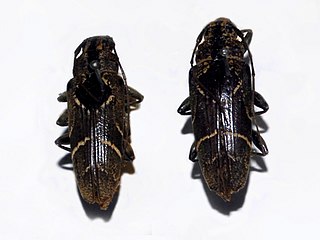
Caenorhabditis elegans is a free-living transparent nematode about 1 mm in length that lives in temperate soil environments. It is the type species of its genus. The name is a blend of the Greek caeno- (recent), rhabditis (rod-like) and Latin elegans (elegant). In 1900, Maupas initially named it Rhabditides elegans. Osche placed it in the subgenus Caenorhabditis in 1952, and in 1955, Dougherty raised Caenorhabditis to the status of genus.

Leonardo Fea was an Italian explorer, zoologist, painter, and naturalist.
Maximilian Spinola was an Italian entomologist.

Most animal testing involves invertebrates, especially Drosophila melanogaster, a fruit fly, and Caenorhabditis elegans, a nematode. These animals offer scientists many advantages over vertebrates, including their short life cycle, simple anatomy and the ease with which large numbers of individuals may be studied. Invertebrates are often cost-effective, as thousands of flies or nematodes can be housed in a single room.

RaffaelloGestro was an Italian entomologist who specialised in Coleoptera. Gestro was the Director of the Natural History Museum of Giacomo Doria Genoa where his collection is conserved. He was a Member and President of the Italian Entomological Society.
Pietro Mansueto Ferrari was an Italian entomologist who specialised in Hemiptera, particularly Auchenorrhyncha.

Protopaussus is a genus of ground beetles in the family Carabidae, the sole genus of the tribe Protopaussini. It is found in Indomalaya and temperate Asia.

Mathilda is a genus of sea snails, marine gastropod mollusks in the family Mathildidae.

Ceroplesis is a genus of flat-faced longhorn beetle in the subfamily Lamiinae of the family Cerambycidae.

Tmesisternus is a genus of longhorn beetles belonging to the family Cerambycidae, subfamily Lamiinae.

Ceroplesis calabarica is a species of beetle in the family Cerambycidae. It was described by Louis Alexandre Auguste Chevrolat in 1858. It is known from Angola, Benin, the Democratic Republic of the Congo, Cameroon, Gabon, Equatorial Guinea, Ghana, Mozambique, Nigeria, Kenya, the Republic of the Congo, Uganda, Togo, and Zambia. Its diet includes Coffea arabica and Coffea canephora.

Ceroplesis quinquefasciata is a species of beetle in the family Cerambycidae. It was described by Johan Christian Fabricius in 1792. It is known from Angola, the Democratic Republic of the Congo, the Central African Republic, Cameroon, the Republic of the Congo, Equatorial Guinea, Ethiopia, Saudi Arabia, South Africa, Senegal, Togo, Tanzania, Zambia, and Uganda.

Rhinochelys is an extinct genus of sea turtles belonging to the family Protostegidae.
Macrocoma fuscoaenea is a species of leaf beetle found in Ethiopia, Tanzania and the Democratic Republic of the Congo. It was first described by Félicien Chapuis in 1879.

Paraivongius bicolor is a species of leaf beetle of Angola and the Democratic Republic of the Congo. It was first described from Landana by Édouard Lefèvre in 1885.

Callispa is a genus of tortoise beetles.
Culex elegans is a species of mosquitoes in the subfamily Culicinae. Insectoid.info treats the name as a separated species, whereas Encyclopedia of Life lists it as a synonym for Aedes aegypti. Ian Macdonald described it in 1899 as not associated with malaria.

Pseudocolaspis is a genus of leaf beetles in the subfamily Eumolpinae. It contains about 80 species, which are found in tropical Africa.

Eurydemus is a genus of leaf beetles in the subfamily Eumolpinae. It is known from Africa and Fiji.

Cosmodela barmanica is a species of tiger beetle found in Asia. The species was formerly treated as a subspecies of Cosmodela duponti. The species has a disjunct distribution with one population in the Western Ghats of India and another extending from the northeast of India into Thailand, Myanmar until Malaysia.















